Ham Radio: the saga continues
In part one of the story I talked about how I got hooked on amateur radio overnight, crammed some textbooks for two weeks, and passed my Technician and General exams. With a newly-issued FCC callsign in hand, it was a bright future ahead!
Well, two weeks later, and I’ve still not made a single successful contact with anyone. It’s been frustrating. I started out ordering a small handheld walkie-talkie radio (“HT” is the lingo). Hams use these for VHF/UHF socializing within a radius of a dozen miles or so. For three nights I listened to hams chatting around the Chicago area, but whenever I tried to transmit and say hello, they couldn’t hear me. At one point someone thought they could hear me and asked me turn “turn up the power”, but I was already at the 5 watts maximum. Then the INTERNET told me that the standard rubber-duck antennas that ship with these tiny radios can’t hit the side of a barn. No problem. I order a much nicer, longer antenna with rave reviews. But nothing gets any better — I still can’t hit a repeater 4 miles away on the top of a Chicago skyscraper in the heart of downtown. What gives? Do I need to build myself a handheld directional antenna, like a mini-dish I can aim eastward?
Meanwhile, my mentor (or ‘elmer’ as hams call it) popped in to visit today from Virginia. He brought with him a special 40-foot long wire which works as an antenna on the low-frequency, long-wavelength radio bands. These are the wavelengths which travel hundreds (or even thousands) of miles by bouncing around off the ionosphere. All you have to do is string the wire across the backyard about 30′ up, and then run a coax cable into the tip of it. The other end of the coax cable goes into your radio. Well, my buddy wasn’t kidding about how you “always remember an antenna hang”. It was like doing a barn raising! It took us all afternoon.
We started by going into the alley and tying a heavy weight (in this case, a dead wall wart) to a piece of string. Wife and wee boys all gathered round to watch.
 |
| From antenna hang |
Of course, we had the official Antenna Book from ARRL, a worthy tome to give us luck.
 |
| From antenna hang |
With great dexterity, my friend flung the rope into the tree, but missed a couple of times.
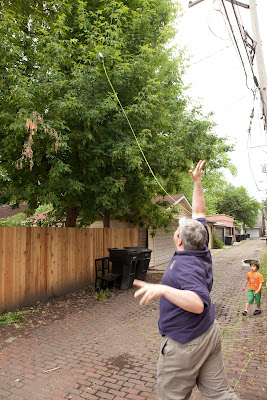 |
| From antenna hang |
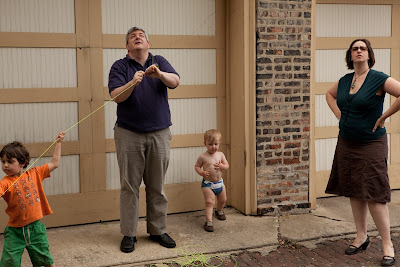 |
| From antenna hang |
Eventually I gave the throw a shot and managed to get it exactly through the right spot in the tree on the second try. Then we had to reel up the official tie-line.
 |
| From antenna hang |
Next, we took 120 feet of RG-8X coaxial cable and pushed half of it through a hole in our basement window. The hole was conveniently left there after I asked AT&T to come over last week and remove our completely unused land lines. We could even reuse the braces going alongside the house and upwards! Of course what I’m not showing here is the hour of soldering PL-259 connectors to each end of the cable. 🙂
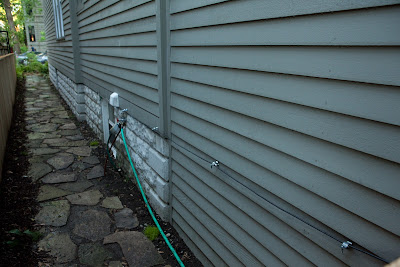 |
| From antenna hang |
 |
| From antenna hang |
Once the cable reached the window of my son’s bedroom, I was ready to drill an eyelet outside the window as a ‘launch point’ for the antenna, and plug the coax feed line into it. I’m sure my wife didn’t mind me drilling into the house at all.
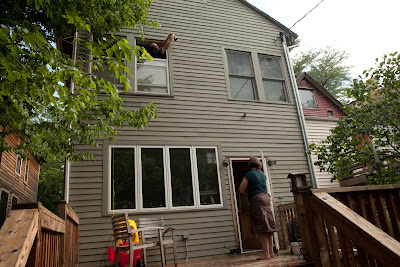 |
| From antenna hang |
…and then screwing in a hook…
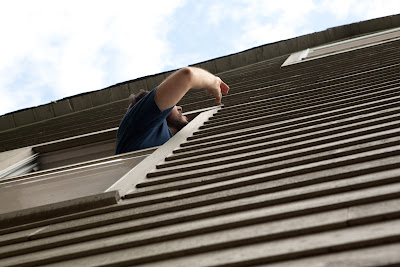 |
| From antenna hang |
In the end, the antenna was pulled up to the hook and now looks like this from the back porch.
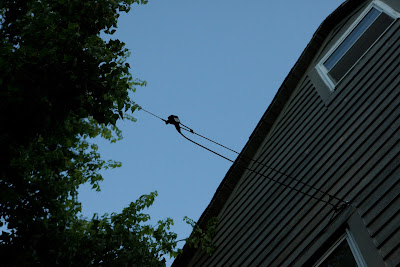 |
| From antenna hang |
…which is actually much less conspicuous than the power line. In fact, if you stand on the porch and look across the backyard, you can’t even see the antenna line.
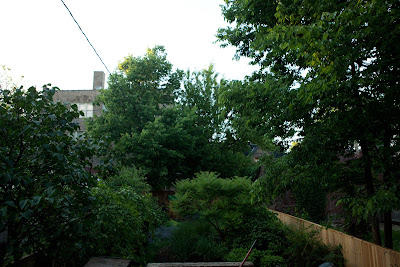 |
| From antenna hang |
In that picture above, the line on the left is the power line. The antenna line on the right goes through the tree and is just too thin to see!
And now for the second disappointment. After that whole afternoon, we went down to the basement and plugged our walkie-talkies into the new super antenna and tried to listen to the low frequencies. Nothing! That’s right, instead of hearing people talking, we heard nothing but static and reflected images of overpowered AM stations. Now Chicago is definitely overcrowded, RF-wise. But something is definitely weird and wrong. Neither of our radios could hear anything, and even after dark (when the ionosphere works better for bouncing long wavelengths) things only barely improved. We have no idea what’s wrong, so I may invite another ham over with Big Desktop Ham Radio to see if things are really messed up somewhere, or if the handheld radios are just too awful to isolate signal from noise.
One thing is certain: this hobby is going to take a lot of patience.